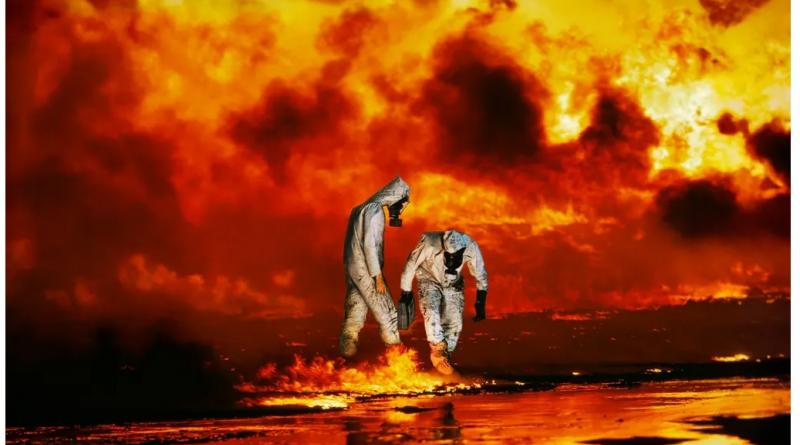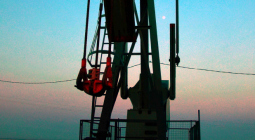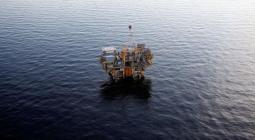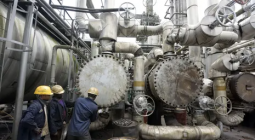‘Gushing oil and roaring fires’: 30 years on Kuwait is still scarred by catastrophic pollution

Oilwells set alight by Iraqi forces in 1991 were put out within months, but insidious pollution still mars the desert
For 10 months in Kuwait, everything was upside down. Daytime was full of darkness from the thick smoke, and nights were bright from the distant glow of burning oilwells.
When Iraq’s leader, Saddam Hussein, ordered the occupation of Kuwait in August 1990 in an attempt to gain control of the lucrative oil supply of the Middle East and pay off a huge debt accrued from Kuwait, he was fairly quickly forced into retreat by a US coalition which began an intensive bombing campaign.
But as Iraqi forces pulled out, in a final vengeful act they deliberately set more than 700 oilwells ablaze. Three decades later, despite promise after promise, Kuwait is still scarred by catastrophic damage from what is regarded by some as one of the world’s worst environmental catastrophes – and the billions set aside for remediation are still waiting to be spent.
“The sound of gushing oil and roaring fires is still in my memory,” remembers Dr Samira Omar Asem, the principal research scientist at the Kuwait Institute for Scientific Research (KISR). “I remember seeing a dead goat sinking in an oil lake.”
The oilwells burned uncontrollably. The smoke plume above them initially stretched for 800 miles. A staggering 11m barrels of crude oil poured into the Persian Gulf, creating a slick nine miles long. Nearly 300 oil lakes formed on the surface of the desert, polluting the soils.
An international coalition of firefighters battled the fires for months until the last well was finally capped on 6 November 1991 and Kuwait celebrated under clear skies.
But today more than 90% of the unprotected contaminated soil remains exposed in the environment. Access to the contaminated sites is restricted, partly due to safety concerns arising from the littering of explosives left behind by Iraqi troops during their retreat. Photos from field research conducted between 2012 and 2019 show that the pollution takes all sorts of forms. Contamination in some wellheads currently runs as deep as four metres.
Most of the damage was sustained within the Burgan oilfields in the southern deserts of Kuwait, an arid land 500 sq km wide housing more than 100 contaminated oil lakes. In one particularly badly affected oil lake known as Lake 105, images show meters-wide circles of black sludge.
According to Meshari Almutairi, an environmental consultant with the Kuwait Oil Company, when he first visited the lake in 2015, he was able to shovel out the soil to expose a gradient of brown, as an indicator of pollution levels. Darker, more heavily contaminated soil at the top, fading into a healthy beige of undamaged soil near the bottom.
He also saw huge pools of black oil deep enough to have drowned migratory birds falling into the oily grounds.
Now, with increasing temperatures and weathering of the soil, the sludge has hardened and had become impenetrable.
“When I tried to collect some samples recently, I needed to go to the edge and take out the surface, and I could not put my shovel in as I used to do before,” he said. “I tried two, three times, and couldn’t pick it up. It was like black ice.”
Elsewhere in the northern oilfields of Raudhatain and Umm al-Aish, the source of Kuwait’s only two freshwater aquifers, visible crusts of dry oil lakes cover the tainted soil.
Although Almutairi says that wind-blown sand has covered parts of the oil lakes in the north and south-east, multiplying its number over the years, harmful chemicals still remain in the soil today.
“Had Kuwait decided to treat this contamination in 1993 or 1994, it would have been so easy. But after 30 years, you are not dealing with the crude oil that existed at that time,” he said. “It’s a very big challenge.”
According to the KISR, just 2.3m cubic meters of the polluted sands – close to 10% – had been successfully removed as of June 2021 in a process known as remediation: roughly 1.7m cubic meters in the north, and 580,000 cubic meters in the south-east, where the Burgan oilfields lie. They estimate that another 19m cubic meters needing to be cleared.
Researchers and conservationists are deeply concerned about the hazards it poses to the ecosystem and human health.
“Any pollution in land or water should be treated as soon as possible,” said Asem. “The desert of Kuwait has valuable resources that need to be protected and preserved.”
It’s the exposure to petroleum hydrocarbons, a mixture of chemicals found in crude oil, that is causing the biggest concern.
Known as the most frequent type of environmental contaminant, any introduction of petroleum hydrocarbons to a pristine environment immediately results in reduced ecosystem functionality.
They are already altering soil properties and causing extensive plant and animal mortality, and they’ve also seeped into fresh groundwater aquifers in northern Kuwait, used for irrigation, in small industries and within distilled water.
Plant life has yet to recover around the contaminated sites, says Mohammed Mahmoud, director of the climate and water programme and a senior fellow at the Middle East Institute. Their exposure to petroleum hydrocarbons damaged plant growth and seed germination. Their soil was also clogged by oil and prevented from accessing light, water and nutrients.
“It’s a sort of byproduct of slanted priorities. People didn’t really buzz about this until they started to see plant life being impacted and physically seeing decay of the natural landscape,” he said.
According to Green Line, an environmental NGO in Kuwait, the surrounding wildlife that lives and relies on the desert vegetation has been noticeably scarce over the years.
“We know this is definitely one of the causes of the depletion of the wildlife stock here in Kuwait,” the group said.
Although the ecosystem will eventually recover, says Sara Akbar, a chemical petroleum engineer and co-founder of Kuwait Energy, many species and areas are still fighting for their health 30 years later.
And Kuwait’s people have suffered effects to their health, too. Akbar and Jeffery Hall, a US veteran who was enlisted during the Gulf war, are among many who experienced severe lung damage after breathing in the toxins from the smoke.
“The doctor said it was as if I was smoking three packs of cigarettes every day for three years. Those were the kind of lungs I had,” said Akbar, who was the sole female firefighter dousing the oilwells.
For Hall, who was exposed to the toxins for a week during his time in Kuwait, his diagnosis in 2017 with pulmonary sarcoidosis, a rare disease forming small lumps of inflammatory cells, is a damage that will last a lifetime.
“It’s likely from the toxic exposure to oilwells and burn pits,” he said. “I now have no immune system.”
These hazards, though recognised by the Kuwait government and international communities, have only slowly led to remediation efforts.
The money is there. In 2005, The UN compensation commission awarded Kuwait with approximately $3bn (£2.2bn) to tackle the environmental damage caused. The largest portion of the funds, amounting to more than $2bn (£1.5bn), went towards the remediation of 114 sq km of damaged sites and efforts to conduct revegetation.
But the delays have been incessant. After a series of delays from a prolonged tendering cycle, long bureaucratic procedures and last-minute cancellations, the Kuwait Oil Company, which is spearheading the work, awarded two tenders in 2020, with a third expected to be issued before the end of the year to remedy the oilfields focusing in the north and south-east of the country.
The company says it plans to complete the remaining amount by 2024. But that timeline is greeted with disbelief by most people. “It’s a huge amount of soil,” said a representative of Green Line, who asked to remain anonymous. “The process by itself will take time and effort. Even if they were realistic about this timeline, there’s no way they’re going to make it.” Kuwait Oil Company was approached for comment but did not respond.
Initial plans involved burying contaminated soil in landfills, with an aim to build more than a dozen more. But fears of intensifying the problem later on led Kuwait to consider proposals to use bioremediation, a process using microorganisms to naturally break down and decay hydrocarbons.
“I think we are on track for complete clearance of all contaminated soil,” said Akbar. “But it took a long time with the bureaucracy. Finally, I think with these contracts we should be fine.”
Others are not so optimistic, as bioremediation techniques are proving to be arduous and complicated.
Recent field research is showing that due to the high presence of petroleum hydrocarbons and the concentration of salt content in Kuwait’s contaminated soil, bioremediation may not be effective.
“The problem is how effective it will be, and even if it does work, it will probably take much longer because of the salinity of the soil that’s working to counteract the effectiveness of the microorganisms,” said Mahmoud.
The swift response to recap the burning wells 30 years ago was regarded as a considerable achievement worldwide, but the efforts of postwar environmental restoration have yet to be seen.
Iraq has paid out more than $50bn (£37.85bn) in reparations worldwide for losses incurred during the first Gulf War. An outstanding payment of $1.7bn (£1.3bn) remains for Kuwait.
“Kuwait is working hard to restore the damage. However it will never go back to its pristine stage,” said Asem.






